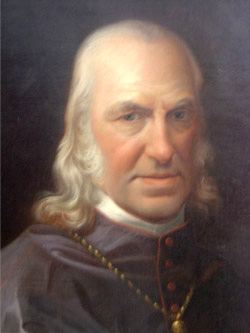Term ended 17 September 1860 | Appointed 29 September 1850 Diocese Diocese of Beverley Name John Briggs | |
 | ||
Ordination 19 July 1814 (priest)by William Gibson | ||
John Briggs (20 May 1789 – 4 January 1861) was an English prelate of the Roman Catholic Church. He served as the first Bishop of Beverley from 1850 to 1860.
Contents
Early life
John Briggs was born in Barton Moss, near Eccles, Lancashire, England. He began training for the priesthood, aged 15, at Ushaw College in County Durham. He received the Tonsure and the four Minor Orders on 14 December 1804. Afterwards, he was ordained a subdeacon on 19 December 1812, a deacon on 3 April 1813, and a priest on 19 July 1814; all ordinations by William Gibson, Vicar Apostolic of the Northern District. Briggs left the college in 1816, but returned when elected President of Ushaw College on 28 March 1828. He remained at the college until 11 August 1832.
Episcopal career
On 22 January 1833, he was appointed Coadjutor Vicar Apostolic of the Northern District. He received his episcopal consecration at Ushaw College on 29 June 1833, the principal consecrator was Bishop Thomas Penswick, Vicar Apostolic of the Northern District, and the principal co-consecrators were Bishop Peter Augustine Baines, Vicar Apostolic of the Western District and Bishop Thomas Walsh, Vicar Apostolic of the Midland District.
On the death of Bishop Thomas Penswick on 28 January 1836, Briggs succeeded as Vicar Apostolic of the Northern District. In 1840, two vicariates apostolic were created out of the Northern District, with Bishop Briggs appointed Vicar Apostolic of the Yorkshire District on 3 July 1840.
On the restoration of the Catholic hierarchy by Pope Pius IX on 29 September 1850, he was appointed Bishop of the Diocese of Beverley. He resigned as Bishop of Beverley on 17 September 1860 and died at his house in York on 4 January 1861, aged 72. A solemn Requiem Mass was held at St George's Pro-Cathedral, York on 9 January, followed by the bishop's burial in St. Leonard's Chapel, Hazlewood, near Tadcaster on 10 January 1861.
